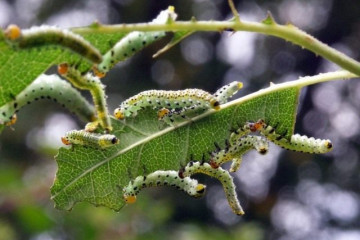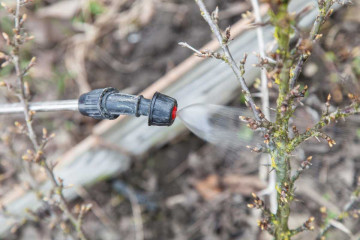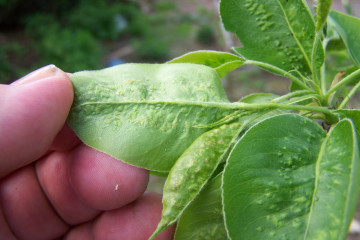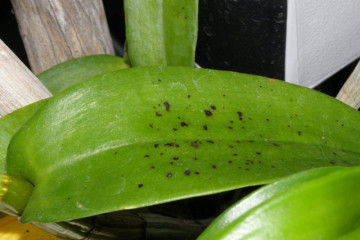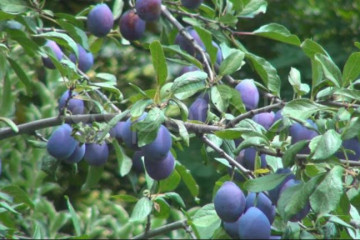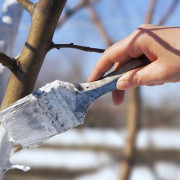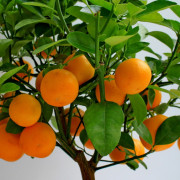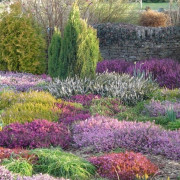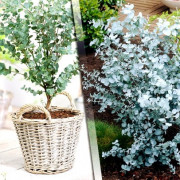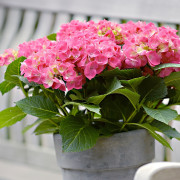Plum clasterosporium disease - how to process the leaves into a hole on the plum
Content:
To take the right preventive actions and organize the treatment of diseases, you need to be able to recognize their signs. In this case, it is worthwhile to distinguish what the disease is provoked by: bacteria or viruses. The material below will provide detailed information about such an ailment as plum clotterosporia.
Spread

Plum tree disease
The causative agent of apricot and plum clasterosporium is the fungus Clasterosporium carpophilum, its source is plant remains, the tissues of which contain fungal spores. They are located near other trees, easily infesting them.
The infection is spread by wind, rain and insects. Infected trees become foci of spraying of conidia - immobile spores. They fly long distances.
If these spores reach the foliage or branch of a plum in a high humidity environment, infection can occur as the spores penetrate the tree tissue. Plum clasterosporiasis infects not only the leaves, but also the rest of the plant above the ground. Buds, flowers and stems are no exception.
Disease development scheme
Clasterosporium disease of apricot, peach, cherry and plum develops according to the following pattern:
- Initially, small dark blotches may appear on barely blossoming foliage - their diameter does not exceed 1 mm. They have a rounded shape with a pale yellowish tint.
- The blotches gradually become larger, growing up to 10 mm in diameter. Their color becomes dark brown or brownish.
- Most of the spots dry out after 2 weeks, they crack, begin to turn yellow, because of this, the leaves fall off, since a large number of holes are formed on them.
Most infected kidneys do not open and become covered with gum. They dry out, acquiring a dark shade, do not fall off and preserve fungal spores in their scales. They winter in the form of mycelium and condia, and in spring they continue to attack the aboveground parts of garden crops.
Initially, the shoots are reddish-purple in color. After 10-15 days, their color changes to pale yellow with a reddish edging. These areas dry out and cracks with gum appear.
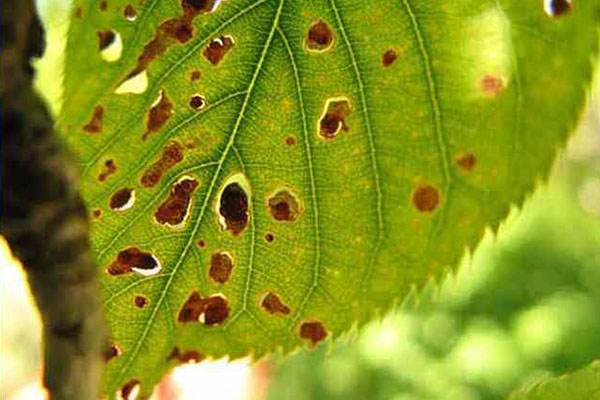
The defeat of the foliage of the garden culture
Signs of clotterosporia
Symptoms of the disease include:
- at the beginning of spring, small red-brown spots form on the foliage;
- the spots gradually grow and become brown with a raspberry tint around the edges;
- plum leaves with holes become later - when the spots have already increased;
- each affected leaflet gradually dries up and falls off prematurely;
- flowers can also turn black and crumble;
- darkened buds do not fall off, but are covered with gum.
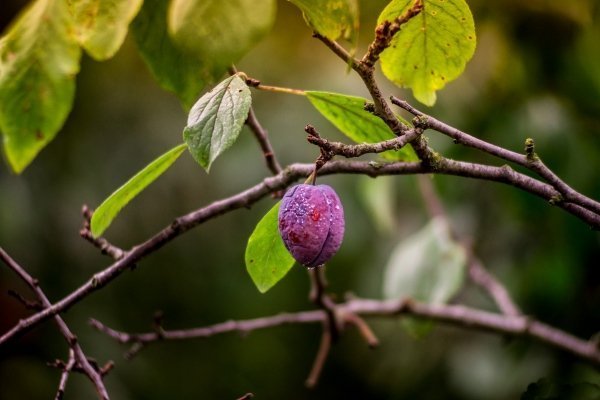
Kidney damage with disease
Treatment
If a gardener discovered plum clotterosporia, how to treat and how to protect the tree from death should be carefully studied. Indeed, due to this disease, all aerial parts of the plant suffer.
The fight against the defeat of horticultural culture should be carried out by:
- Removal of the affected elements with their incineration.
- Cleaning wounds and disinfecting them with iron or copper sulfate, putty with oil paints or garden broth.
- By treating wood with chemicals such as potassium chloride and copper oxychloride, as well as Fitosporin. The procedure should be carried out in early spring, when the growing season of the plant begins.
To make a solution of potassium chloride, you need to dilute 1 kg of the substance with 10 liters of water. Spraying should be carried out until the foliage blooms. During the growing season, it is worth treating the garden with a 10-fold reduction in consumption.
Copper oxychloride must be combined with water in such a volume - 30-40 g per 10 liters. You need to spray four times:
- when the kidneys swell;
- at the moments of the pink bud phase;
- the remaining 2 times with an interval of 15 days.
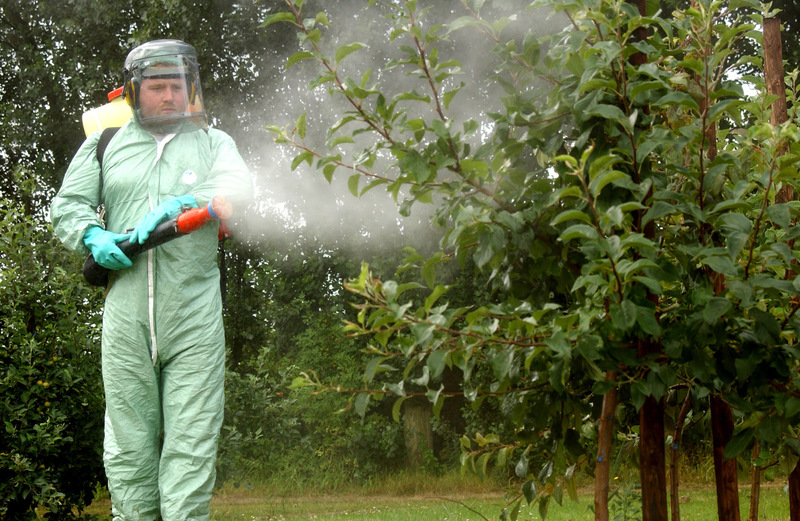
Spraying process for horticultural crops
What is the danger of klyasterosporium
The disease is quite dangerous for stone fruit trees. Indeed, due to the manifestation of symptoms, a large number of branches are affected. If you do not start to heal the tree in time, its parts gradually die off. If plum leaves are in a hole, what to do and how to treat is described above.
Traditional methods of treatment
It is more difficult to completely cure the garden with folk measures to combat clasterosporia of stone fruit crops. They should be used as additional activities. Experienced gardeners carry out the treatment of the garden against the fungus using:
- Slaked lime, which must be diluted in a 1: 5 ratio. Trees must be processed again after 10 days.
- Tinctures based on mustard leaves, which should be brewed at the rate of 1 kg per 15 liters of water. The medicine is prepared for 2 days. Before using it, strain it, then spray the trunk and branches.
- A decoction with horse sorrel in the base, which should be prepared by steaming 1 kg of roots in 20 liters of boiling water. The resulting mixture should be infused for at least 6 hours.
- Infusions of 3 kg of dried tobacco, 0.5 kg of laundry soap. These components are poured into 20 liters of boiling water. After which the mixture is infused for 2 days in a cool dark place.
- Removing manually formed gum and treating cracks with copper sulfate 3%.
Gardeners often make mistakes that lead to the death of stone fruit crops.
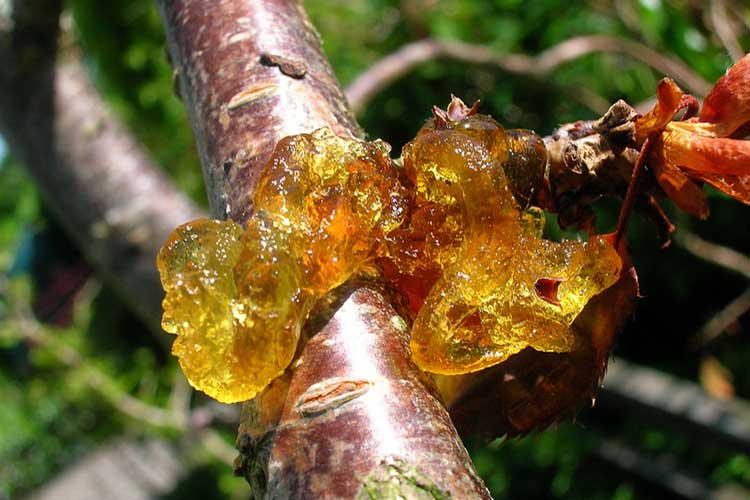
Stone tree gum
Spraying with Bordeaux mixture for clasterosporium
This liquid is a mixture of copper sulfate with lime and water. It must be used to combat fungal and bacterial diseases. After preparing a strong or gentle solution, it must be left to infuse for about 3-4 hours, filtered and poured into a sprayer. A freshly prepared preparation can be used throughout the day, after which the shelf life expires.
Spraying trees with Bordeaux mixture against the disease should be taken seriously. Processing in relation to stone fruit is accompanied by the following actions:
- inhibition of the growth of young shoots;
- poor aging of wood;
- reduced winter hardiness of the plant.
Prevention of clotterosporia
In order to prevent the onset of the disease, it is worth applying agrotechnical measures in the form of:
- regular pruning of affected shoots until summer;
- cleaning the garden area;
- deep plowing of fallen leaves;
- increasing air circulation in the garden as much as possible;
- control of the garden getting the required level of nitrogen and antagonistic microorganisms;
- reducing the risk of infection due to the creation of favorable conditions for rapid germination and healthy growth of seedlings, without worms;
- attempts to extract branches on trees that are in contact with each other;
- using a thick layer of mulch around the trunk of each tree after cleaning it (this prevents the spread of weeds and the entry of pathogens on the foliage);
- obligatory disinfection of the instrument after each of the incisions - for this it is enough to dilute the bleach with water in a ratio of 1: 4.
With timely noticed symptoms of the disease, you can get rid of its development and provide timely assistance to garden crops. Attentive attitude to plants on the part of the gardener is a guarantee of the impeccable condition of the fruit trees on the site.
